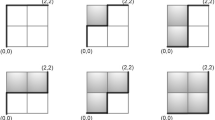Abstract
In this paper, we make a novel connection between information theory and additive combinatorics; more specifically, between deletion/insertion correcting codes and the celebrated Littlewood–Offord problem. We see how results from one area can have an impact on the other area and vice versa. In particular, a result on the Littlewood–Offord problem gives a nice upper bound for the size of the Levenshtein code and the Helberg code (and possibly other variants of these codes). Also, a recent result on the deletion correcting codes gives a modular analogue of the Littlewood–Offord problem which generalizes the results of Vaughan and Wooley (Q J Math Oxf Ser (2) 42(2):379–386, 1991) (obtained using tools from analytic number theory and properties of exponential sums) and of Griggs (Bull Am Math Soc (N.S.) 28:329–333, 1993) (obtained using a combinatorial argument). This novel connection might opens up new doors to research in these or other related areas.
Similar content being viewed by others
References
Balister P., Bollobás B.: Projections, entropy and sumsets. Combinatorica 32, 125–141 (2012).
Bibak, K.: Additive combinatorics with a view towards computer science and cryptography, Number Theory and Related Fields: In Memory of Alf van der Poorten (Borwein, J.M., Shparlinski, I.E., Zudilin, W. eds.), Springer Proceedings in Mathematics & Statistics, Vol. 43, Springer, New York, p. 99–128 (2013).
Bibak K., Kapron B.M., Srinivasan V.: Unweighted linear congruences with distinct coordinates and the Varshamov-Tenengolts codes. Des. Codes Cryptogr. 86, 1893–1904 (2018).
Bibak K., Kapron B.M., Srinivasan V., Tauraso R., Tóth L.: Restricted linear congruences. J. Number Theory 171, 128–144 (2017).
Bibak, K., Milenkovic, O.: Weight enumerators of some classes of deletion correcting codes. In: Proceedings of the 2018 IEEE International Symposium on Information Theory—ISIT, pp. 431–435. (2018)
Bourgain J., Dilworth S., Ford K., Konyagin S., Kutzarova D.: Explicit constructions of RIP matrices and related problems. Duke Math. J. 159, 145–185 (2011).
Boyer, M.: Extended GHZ n-player games with classical probability of winning tending to 0. arXiv:quant-ph/0408090 (2004).
Candès E.J.: The restricted isometry property and its implications for compressed sensing. C. R. Math. Acad. Sci. Paris 346, 589–592 (2008).
Candès E.J., Romberg J.K., Tao T.: Stable signal recovery from incomplete and inaccurate measurements. Commun. Pure Appl. Math. 59, 1207–1223 (2006).
Candès E.J., Tao T.: Decoding by linear programming. IEEE Trans. Inf. Theory 51, 4203–4215 (2005).
Chen H.: Excursions in Classical Analysis: Pathways to Advanced Problem Solving and Undergraduate Research. Mathematical Association of America, Washington, DC (2010).
Delsarte Ph, Piret Ph: Spectral enumerators for certain additive-error-correcting codes over integer alphabets. Inf. Control 48, 193–210 (1981).
Frankl P., Füredi Z.: Solution of the Littlewood–Offord problem in high dimensions. Ann. Math. 128(2), 259–270 (1988).
Gabrys R., Yaakobi E., Milenkovic O.: Codes in the Damerau distance for deletion and adjacent transposition correction. IEEE Trans. Inf. Theory 64, 2550–2570 (2018).
Ginzburg B.D.: A certain number-theoretic function which has an application in coding theory. Probl. Kibernet. 19, 249–252 (1967). Russian.
Griggs J.R.: On the distribution of sums of residues. Bull. Am. Math. Soc. (N.S.) 28, 329–333 (1993).
Helberg A.S.J., Ferreira H.C.: On multiple insertion/deletion correcting codes. IEEE Trans. Inf. Theory 48, 305–308 (2002).
Helleseth T., Kløve T.: On group-theoretic codes for asymmetric channels. Inf. Control 49, 1–9 (1981).
Kelarev A., Ryan J., Rylands L., Seberry J., Yi X.: Discrete algorithms and methods for security of statistical databases related to the work of Mirka Miller. J. Discret. Algorithms 52(53), 112–121 (2018).
Kløve T.: Error Correcting Codes for the Asymmetric Channel. Tech. Rep., Department of Informatics, University of Bergen, Bergen (1995).
Korobov N.M.: Exponential Sums and their Applications. Springer, Dordrecht (1992).
Le T.A., Nguyen H.D.: New multiple insertion/deletion correcting codes for non-binary alphabets. IEEE Trans. Inf. Theory 62, 2682–2693 (2016).
Levenshtein, V.I.: Binary codes capable of correcting deletions, insertions, and reversals (in Russian), Dokl. Akad. Nauk SSSR 163 (1965), 845–848. English translation in Soviet Physics Dokl. 10, 707–710 (1966).
Littlewood J.E., Offord A.C.: On the number of real roots of a random algebraic equation. Mat. Sb. 12, 277–286 (1943).
Lovett S.: Additive combinatorics and its applications in theoretical computer science. Theory Comput. Grad. Surv. 8, 1–55 (2017).
Madiman, M., Marcus, A., Tetali, P.: Information-theoretic inequalities in additive combinatorics, In: Proc. of the 2010 IEEE Information Theory Workshop, pp. 1–4 (2010).
Madiman M., Marcus A., Tetali P.: Entropy and set cardinality inequalities for partition-determined functions. Random Struct. Algorithms 40, 399–424 (2012).
McEliece R.J., Rodemich E.R.: The Constantin-Rao construction for binary asymmetric error-correcting codes. Inform. Contr. 44, 187–196 (1980).
Plagne A., Schmid W.A.: An application of coding theory to estimating Davenport constants. Des. Codes Cryptogr. 61, 105–118 (2011).
Ruzsa I.Z.: Sumsets and Entropy. Random Structures Algorithms 34, 1–10 (2009).
Schoeny C., Wachter-Zeh A., Gabrys R., Yaakobi E.: Codes correcting a burst of deletions or insertions. IEEE Trans. Inf. Theory 63, 1971–1985 (2017).
Sloane, N.J.A.: On single-deletion-correcting codes, In Codes and Designs, Ohio State University, May 2000 (Ray-Chaudhuri Festschrift), Arasu, K.T., Seress, A., (editors), Walter de Gruyter, Berlin, pp. 273–291 (2002).
Stanley, R.P., Yoder, M.F.: A study of Varshamov codes for asymmetric channels. Jet Propulsion Laboratory, Technical Report 32–1526, Vol. XIV, 117–123 (1973).
Tao T.: Sumset and inverse sumset theory for Shannon entropy. Comb. Probab. Comput. 19, 603–639 (2010).
Tao T., Vu V.: Additive Combinatorics. Cambridge University Press, Cambridge (2006).
Varshamov, R.R., Tenengolts, G.M.: A code which corrects single asymmetric errors (in Russian), Avtomat. i Telemeh. 26 (1965), 288–292. English translation in Automat. Remote Control 26, 286–290 (1965).
Vaughan R.C., Wooley T.D.: On a problem related to one of Littlewood and Offord. Q. J. Math. Oxf. Ser. 42(2), 379–386 (1991).
Acknowledgements
The author is grateful to the anonymous referees for a careful reading of the paper and helpful suggestions.
Author information
Authors and Affiliations
Corresponding author
Additional information
Communicated by V. A. Zinoviev.
Publisher's Note
Springer Nature remains neutral with regard to jurisdictional claims in published maps and institutional affiliations.
Rights and permissions
About this article
Cite this article
Bibak, K. Deletion correcting codes meet the Littlewood–Offord problem. Des. Codes Cryptogr. 88, 2387–2396 (2020). https://doi.org/10.1007/s10623-020-00787-y
Received:
Revised:
Accepted:
Published:
Issue Date:
DOI: https://doi.org/10.1007/s10623-020-00787-y




